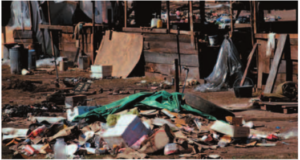ГДЗ по английскому языку 11 Класс класс Афанасьева О.В., Дули Д., Михеева И.В. упражнение - 96 р. 1
Shanty Towns
What exactly is a shanty town?
A shanty town (or slum) is an overcrowded community of rough huts or poor quality houses which have 1) ….. or no access to basic services like clean water and electricity. Shanty towns are usually located on the outskirts of cities, or on dangerous or worthless land that no one else wants. Since shanty towns are illegal, governments don’t have to provide the people who live in them with medical care, education, or other basic services and rights.
Why do they develop?
Every day, approximately 180,000 people around the world move from the countryside into cities. Some move to escape poverty or conflict, others are simply attracted by the prospect of a better life. Unfortunately, in many parts of the developing world, governments have not made plans to cope with the vast numbers of people arriving in their cities each year. In particular,they have failed to provide decent and affordable housing. As a result, many end 2) ….. living in terrible conditions: shanty towns.
What is life like in a shanty town?
Unemployment and poverty levels are high in shanty towns. Malnutrition and child labour are common. Since shanty towns are overcrowded and usually without rubbish collections, clean water or sanitation facilities (in the Kiberaslum in Nairobi, for example, 40,000 people share just 10 toilets), 3) ….. are polluted, filthy environments where disease 4) ….. quickly. Also, the high level of poverty often leads to organised crime and violence. However, these communities are full of life and residents have a high community spirit.
Is anything being done?
International agencies are working with governments of developing countries, and also residents themselves, to improve the situation. For example, charities sometimes offer residents loans so that they 5) ….. set up businesses and 6) ….. a decent living. In Rio de Janeiro, Brazil, the authorities have now officially accepted their country’s shanty towns as permanent and are providing them with electricity, water and other amenities. But slum dwellers aren’t just waiting for others to solve their problems! In Thailand, slum communities have worked together to resolve arguments over land and in some 7) ….. have gained legal ownership

- Look at the picture. What is a shanty town? How can these words be related to it?
- overcrowded community
- basic services
- illegal
- medical care
- unemployment
- poverty
- malnutrition
- child labour
- clean water
- disease
- crime
- legal ownership
- overcrowded community — перенаселенные сообщество
- basic services — основные услуги
- illegal — незаконный
- medical care — медицинская помощь
- unemployment — безработица
- poverty — бедность
- malnutrition — недоедание
- child labour — детский труд
- clean water — чистая вода
- disease — болезнь
- crime — преступность
- legal ownership — законное владение
A shanty town is a deprived urban area characterized by makeshift dwellings built from scrap materials like wood, metal, cardboard, and plastic. These settlements often arise on the outskirts of cities or on land that is publicly owned or otherwise unsuitable for formal development. They are typically built by people who cannot afford formal housing.
- Shanty towns are often densely populated due to the limited space and large numbers of people seeking affordable housing.
- Access to basic services is often severely limited or non-existent. This includes sanitation, waste disposal, electricity, and paved roads.
- Shanty towns are often built on land that the residents do not legally own. Therefore, the settlements are often considered illegal by authorities.
- Access to medical care is extremely limited. There might be a lack of clinics, hospitals, or trained medical personnel within the settlement.
- Unemployment rates are usually high in shanty towns due to a lack of job opportunities and limited access to education and skills training.
- Poverty is a defining characteristic of shanty towns. Residents typically live below the poverty line, struggling to meet their basic needs.
- Due to poverty and lack of access to nutritious food, malnutrition is a common problem, especially among children.
- Due to the economic hardships faced by families, children are sometimes forced to work to contribute to the household income.
- Access to clean water is a major problem. Residents may have to rely on unsafe water sources, leading to health problems.
- Poor sanitation, overcrowding, and lack of access to clean water make shanty towns breeding grounds for infectious diseases.
- Crime rates can be higher in shanty towns due to poverty, lack of opportunities, and social exclusion.
- Legal ownership is not available for those living in shanty towns.